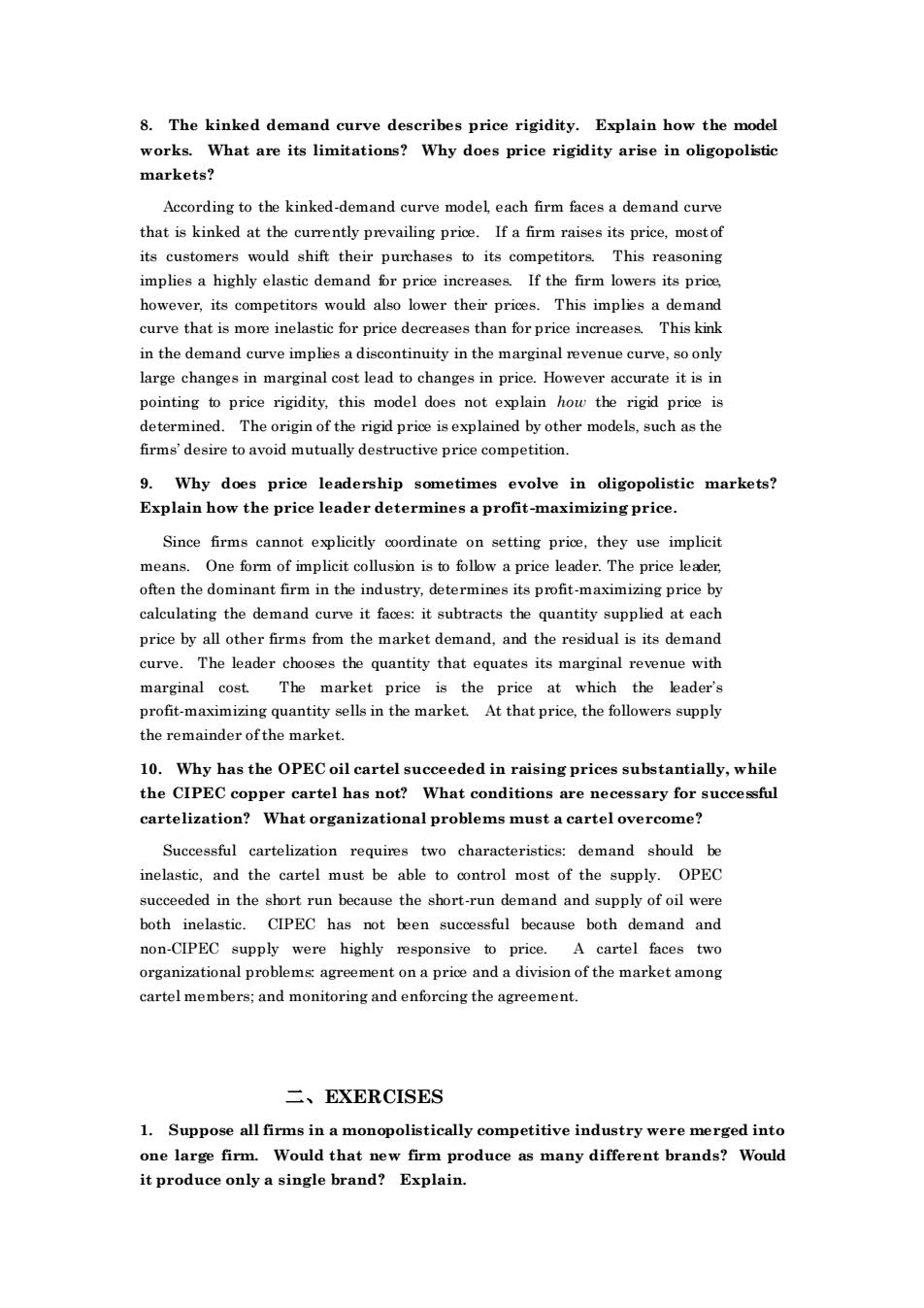正在加载图片...

8.The kinked demand curve describes price rigidity.Explain how the model works.What are its limitations?Why does price rigidity arise in oligopolistic markets? According to the kinked-demand curve model each firm faces a demand curve that is kinked at the currently prevailing price.If a firm raises its price,mostof its customers would shift their purchases to its competitors.This reasoning implies a highly elastic demand for price increases.If the firm lowers its price er its etitor ould also wer thei prices.This This kink in the demand curve implies a discontinuity in the marginal revenue curve,so only large changes in marginal cost lead to changes in price.However accurate it is in pointing to price rigidity.this model does not explain how the rigid price is determined.The ofthe by other firmsdesire to avoid mutually de ructive price competition Why does price leadership sometimes evolve in oligopolistic markets? Explain how the price leader determines a profit-maximizing price. Since firms cannot explicitly coordinate on setting price,they use implicit means.One form of implicit collusion is to follw a price leader.The price leader often the dominant firm in the industry,determines its profit-maximizing price by calculating the demand curve itfaces:it subtracts the quantity supped at each price bya other firms from the market demand,and the residu al is its deman curve.The leader chooses the quantity that equates its marginal revenue with marginal cost The market price is the price at which the leader's profit-maximizing quantity sells in the market.At that price,the followers supply the remainder ofthe market. 10.Why has the OPEC oil cartel succeeded in raising prices substantially,while the CIPEC e pp cartel has not?What conditions are ne essary fo cartelization?What organizational problems must a cartel overcome? Successful cartelization requires two characteristics: demand should be inelastic.and the cartel must be able to control most of the supply.OPEC succeeded in the short run because the short-run demand and supply of oil were both inelastic.CIPEC has not been successful because both demand and non-CIPEC upp were highly price faces organizational proble ms agreement on a price and a division of the market among cartel members;and monitoring and enforcing the agreement. 二、EXERCISES 1.Suppose all firms in a monopolistically competitive industry were merged into one large firm.Would that new firm produce as many different brands?Would it produce only a single brand?Explain.8. The kinked demand curve describes price rigidity. Explain how the model works. What are its limitations? Why does price rigidity arise in oligopolistic markets? According to the kinked-demand curve model, each firm faces a demand curve that is kinked at the currently prevailing price. If a firm raises its price, most of its customers would shift their purchases to its competitors. This reasoning implies a highly elastic demand for price increases. If the firm lowers its price, however, its competitors would also lower their prices. This implies a demand curve that is more inelastic for price decreases than for price increases. This kink in the demand curve implies a discontinuity in the marginal revenue curve, so only large changes in marginal cost lead to changes in price. However accurate it is in pointing to price rigidity, this model does not explain how the rigid price is determined. The origin of the rigid price is explained by other models, such as the firms’ desire to avoid mutually destructive price competition. 9. Why does price leadership sometimes evolve in oligopolistic markets? Explain how the price leader determines a profit -maximizing price. Since firms cannot explicitly coordinate on setting price, they use implicit means. One form of implicit collusion is to follow a price leader. The price leader, often the dominant firm in the industry, determines its profit-maximizing price by calculating the demand curve it faces: it subtracts the quantity supplied at each price by all other firms from the market demand, and the residual is its demand curve. The leader chooses the quantity that equates its marginal revenue with marginal cost. The market price is the price at which the leader’s profit-maximizing quantity sells in the market. At that price, the followers supply the remainder of the market. 10. Why has the OPEC oil cartel succeeded in raising prices substantially, while the CIPEC copper cartel has not? What conditions are necessary for successful cartelization? What organizational problems must a cartel overcome? Successful cartelization requires two characteristics: demand should be inelastic, and the cartel must be able to control most of the supply. OPEC succeeded in the short run because the short-run demand and supply of oil were both inelastic. CIPEC has not been successful because both demand and non-CIPEC supply were highly responsive to price. A cartel faces two organizational problems: agreement on a price and a division of the market among cartel members; and monitoring and enforcing the agreement. 二、EXERCISES 1. Suppose all firms in a monopolistically competitive industry were merged into one large firm. Would that new firm produce as many different brands? Would it produce only a single brand? Explain